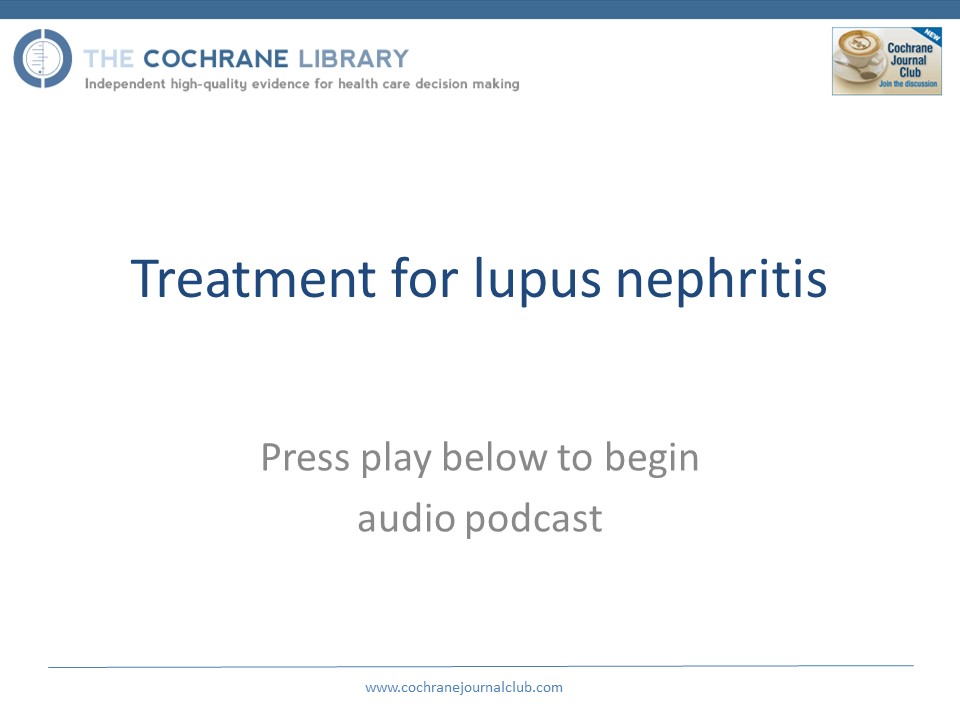Summary
Summary
Lupus nephritis occurs in about half of all people with systemic lupus erythematosus (SLE), leading to end-stage kidney disease (ESKD) in 5% to 10% of patients at 10 years. Studies in the 1970s and 1980s led to the establishment of cyclophosphamide-containing regimens as first line therapy for inducing remission, and survival is now greater than 90%. However, Cyclophosphamide is toxic and associated with high incidence of adverse events. Furthermore, response to treatment is often slow, and although remission is induced in a significant proportion of patients, the risk or relapse or flare remains considerable.
In the past ten years, numerous trials evaluating newer agents (mycophenolate mofetil (MMF), tacrolimus and rituximab) have been published. These have all been proposed as alternative, potentially less toxic, and more effective therapies than cyclophosphamide. This December 2012 update to a Cochrane Review that was last revised in 2004 seeks to evaluate the relative effects of all available immunosuppressive therapies for the induction or maintenance treatment of lupus nephritis.
The principal sources of trials for the review was the Cochrane Renal Groups Specialized Register, which includes more than 18,000 reports. It is the best single source of published trials for inclusion in systematic reviews in kidney disease, and draws on searches of the Cochrane Central Register of Controlled trials, general bibliographic databases of health research such as MEDLINE and EMBASE, and the checking of specialised databases, journals and conference proceedings.
Two authors independently screened all titles and abstracts to determine which studies to include. Data were extracted and quality assessed independently by two authors, with differences resolved by discussion.
A total of 50 trials involving 2846 randomized participants were included in the review. Most of these were of induction therapy, with six studies (514 participants) comparing different forms of maintenance therapy. Many different comparisons had been investigated in the trials, making it difficult to use this large amount of data to answer specific questions; but two comparisons stood out.
Seven trials, including a total of 710 patients, compared MMF against conventional therapy with intravenous cyclophosphamide for induction treatment. In the short term (up to six months), treatment with MMF conferred similar risk of death and progression to end-stage kidney disease as intravenous cyclophosphamide. Renal remission and renal relapse were equally likely with each agent; but MMF was associated with less ovarian failure, leucopenia and alopecia. However, it seemed to increase the risk of diarrhoea.
Three trials (including a total of 371 patients) compared MMF with azathioprine for maintenance therapy. MMF was associated with a significantly lower risk of renal relapse.
Across the review, there is considerable clinical heterogeneity in interventions, definitions of remission, and outcome reporting. These hampered interpretation and presentation of important outcomes in this review. For example, even in the comparison of MMF versus cyclophosphamide, there was variability among studies in therapeutic dosing, route of administration and co-interventions.
There is also a problem with the duration of follow-up in the trials. Although some studies followed patients for one to two years, others were much shorter and inadequately powered to detect events in the clinically important outcomes. For example, the average time to remission with cyclophosphamide is about 10 months, but 10 of the induction therapy studies did not follow their participants beyond six months. Furthermore, the risk of adverse events such as ovarian failure increases after six months, so the power of existing studies, even when combined, to detect significant differences among interventions is limited. The lack of long-term follow-up is particularly relevant to the outcome of ESKD, where a difference between treatments may not become apparent for several years.
In their conclusions, the authors of this updated review draw attention to the similar effects for induction of remission of proliferative lupus nephritis with MMF compared to cyclophosphamide. They draw attention to the significant reduction in toxic effects (ovarian failure, alopecia and leucopenia) with MMF, but note that the significant increase in diarrhea may limit its widespread tolerability. However, particularly for women of child-bearing age, they suggest that the equivalent remission rates combined with a more favourable side-effect profile would support MMF as being superior to cyclophosphamide as induction therapy for lupus nephritis.
In considering the questions that need to be addressed in future studies, the authors reflect on the fact that many of the treatments that are used for lupus nephritis, including rituximab, tacrolimus and cyclosporin, have only been assesses in small randomized trials, with inconsistent outcome reporting. They highlight two main implications for research: firstly, to make better use of existing data, and secondly to strategically plan any new studies. This recognizes that lupus nephritis is uncommon, and requires multicentre collaboration for any study to have an adequate sample size and prolonged follow-up beyond six months to clarify the harms of specific treatment regimens.
Copyright© 2014 The Cochrane Collaboration. Published by John Wiley & Sons, Ltd.



